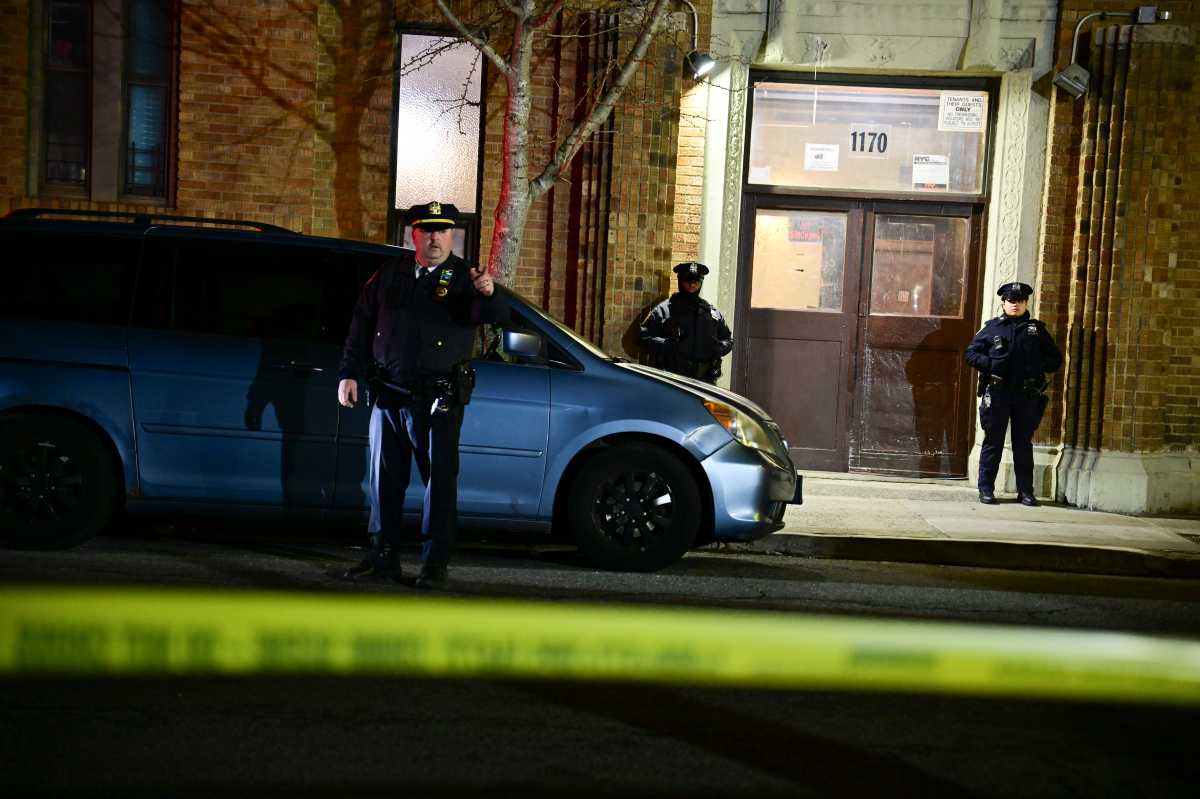By Julie Shapiro
A Silverstein Properties executive slammed the Port Authority’s most recent proposal for the World Trade Center site Monday night but also said it could represent a small step in the right direction.
The Port’s proposal, given to developer Larry Silverstein last Friday, marks the first time the Port has offered to help Silverstein build two of his Church St. office towers. Previously, the Port had offered to help with only one of the towers, which Silverstein said wasn’t good enough.
“I don’t want to be totally negative,” Janno Lieber, president of Silverstein’s W.T.C. Properties, said Monday night, in the firm’s first public comments about the Port’s proposal. “The fact that there’s a new principle, some openness to new ideas, may be favorable,” Lieber continued, “but the substance is the more important thing.”
Lieber found plenty to criticize in the proposal’s substance when he spoke to Community Board 1 Monday night, and he even questioned whether the Port had meant it as a serious offer. The Port’s plan would require Silverstein to raise $625 million for Tower 2, which Lieber said is next to impossible given the frozen credit markets.
If Silverstein raises the money, the Port would then backstop up to $1.2 billion to finance Tower 2 and would also backstop financing for Tower 4, as previously offered.
A Port official, speaking on condition of anonymity, pointed out that under the proposal, Silverstein has two years to raise the $625 million for Tower 2. During that time, the official said, Silverstein can build the belowground portion of the tower. Then, if Silverstein can’t raise the money, Silverstein can build a shorter retail podium instead, the official said.
Lieber, though, said building a retail podium rather than a tower would necessitate an entirely different belowground structure. Some of Tower 2’s security features are in the tower itself and would have to be relocated, Lieber said. While people often think of construction as LEGO, where each piece snaps together independently, Lieber said Tower 2’s design is much more complex and interconnected.
“You cannot just start a building and say, ‘Well, I’ll decide later whether I’m going to finish it,’” Lieber said. He said the firm needs to know that the tower will rise before construction can begin.
Steve Sigmund, Port spokesperson, said replacing Tower 2 with a podium would not require a redesign of the belowground structure.
Sigmund added that the Port’s offer to help with both Tower 2 and Tower 4 is a generous one.
“The bottom line is if Silverstein won’t even accept this significant compromise proposal,” Sigmund said, “it’s clear that no amount of money is good enough and the only thing Silverstein will accept is a fully subsidized [building].”
Silverstein has previously offered to put undisclosed amounts of his own money into Tower 2, but not enough to satisfy the Port. Silverstein is still reviewing the Port’s proposal and has not yet responded formally.
Meanwhile, the Port and Silverstein have a related matter to deal with: On July 6, fed up with the stalled negotiations, Silverstein threatened to bring his concerns to an independent arbitration panel. If a deal does not surface by Monday, either the Port or Silverstein can pursue arbitration, which would likely take months.
The arbitration would not directly focus on how to finance Silverstein’s office buildings. Instead, it would focus on the 2006 rebuilding agreement between Silverstein and the Port Authority, which set a detailed timeline for the delivery of key infrastructure at the site. The Port announced last year that it had fallen far behind on many of those projects, including the PATH hub and the streets and utilities. Silverstein would now use the arbitration process to seek damages for those delays, with an eye toward getting enough cash to build the Church St. office towers himself.
“We’re going to be looking for a significant damage award,” Lieber said Monday. “We’re going to be looking to recoup a lot of the money that we have given the Port Authority.”
The money Lieber referred to totals $2.76 billion, a combination of $780 million in rent Silverstein has paid the authority since 9/11, and insurance proceeds Silverstein gave to the authority when the authority took over building the Freedom Tower in 2006 and responsibility for Tower 5.
“This is a sacred fund, and we gave them all the money,” Lieber said in reference to about $2 billion of the $4.5 billion in insurance Silverstein received after 9/11. “We can’t just walk away. And if we can’t make a new deal, we have to find a way to get the money back so we can build some buildings.”
Sigmund, the Port spokesperson, said it does not make sense for Silverstein to ask for any of the insurance money back now.
“Every dime of that money is going toward rebuilding Downtown, which is what the insurance proceeds are designed to do,” Sigmund said.
Silverstein has already received some compensation for the Port’s delays: For more than a year, the Port has paid Silverstein $300,000 a day, over $100 million, for being late to turn over sites for the Church St. towers. Those daily penalties spurred a previous arbitration last fall, when the Port claimed it could stop paying Silverstein because the sites were done. Back then, the arbitration panel ruled in favor of Silverstein, saying the Port had more work to do. Two of the three arbiters who heard that case would hear the current dispute if it goes to arbitration, Lieber said.
Both the Port and Silverstein have said they would like to continue the separate negotiations about tower financing even if arbitration takes place, but the two sides have not spoken about the financing recently. As a sign of how strained communication is, Lieber said he first heard about the Port’s recent financing proposal to his firm in an online news story, nearly 24 hours before he received a letter from the Port.
After Lieber made Silverstein’s case Monday night to C.B. 1’s W.T.C. Redevelopment Committee, it appeared that some board members were moving closer to Silverstein’s side. In the past, C.B. 1 members have said the Port should keep its money for public infrastructure projects and should not help Silverstein finance his office buildings. But on Monday, several board members sounded convinced by Lieber’s arguments, especially when they heard about all the rent Silverstein had been paying the Port since 9/11.
“I’m frankly shocked about how much money was handed over to the authority,” said Tom Goodkind, a board member. “It puts things in a completely different light.”
The board has not taken an official position.
Board members also had unusually sharp words for the Port Authority Monday night, based on recent press reports about drunken construction workers and a district attorney investigation into payroll fraud.
“I’m completely disgusted with the behavior at the World Trade Center site,” said Joel Kopel, a board member.
Quentin Brathwaite, assistant director of W.T.C. construction for the Port, replied that the Port has inspector generals and constantly reviews what’s happening at the site, but he did not provide specifics and Kopel continued to press him.
“If you have oversight, you’re not doing your job,” Kopel told Brathwaite. “If the buck stops with you, you’re not doing your job. You need to do something about it. It’s not acceptable, it’s just not.”
Brathwaite did not respond directly, but he later said that the Trade Center is a large site and the recent reports of bad behavior represent the actions of only a few. Sigmund, the spokesperson, later added that the Port is making sure contractors and unions understand the site’s zero-tolerance policies.
Brathwaite also provided the board with an update on W.T.C. construction. Before the end of the year, a new crane will arrive on the eastern half of the site to move steel trusses into place for the Santiago Calatrava-designed PATH hub. Rising five-and-a-half stories, the crane will be the largest on the site to date, because it will have to carry steel all the way from Church St. into the center of the site.
“It is absolutely massive,” Brathwaite said.
Brathwaite also said the Port is working on opening the pedestrian passageway that runs beneath the site in December 2012, nearly a year earlier than planned.
Brathwaite declined to answer the community’s questions about the negotiations with Silverstein, but he stayed to listen to Lieber’s presentation — perhaps because the Silverstein team used the Port’s projector — and he did not contradict anything Lieber said.
When Lieber finished answering questions, the community board appeared sobered.
“We really appreciate you coming and giving us this reality check,” chairperson Catherine McVay Hughes said.
Julie@DowntownExpress.com

































